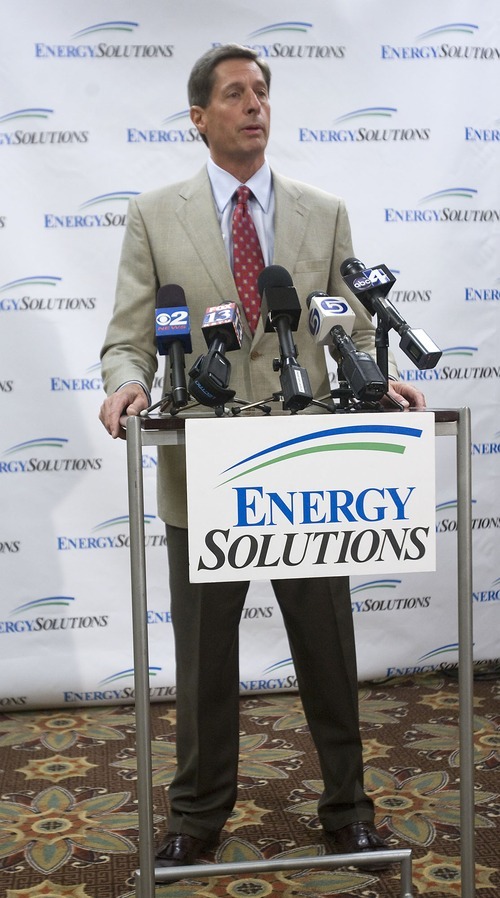This is an archived article that was published on sltrib.com in 2012, and information in the article may be outdated. It is provided only for personal research purposes and may not be reprinted.
A weekend shake-up at EnergySolutions Inc. has toppled the two top executives and left Utahns and investors wondering what's next for the homegrown nuclear-waste company.
Many Utahns hadn't yet brushed their teeth Monday, when the Salt Lake City-based company announced Val John Christensen had resigned on Sunday as the company's president and chief executive officer and a new leader, money-management industry veteran David Lockwood, had taken over. EnergySolutions' board also replaced Chief Financial Officer William R. Benz with Gregory Wood.
Papers filed with the U.S. Securities and Exchange Commission said Christensen will remain a strategic adviser at a consulting fee of $25,000 a month. He and Benz also will receive severance payouts — $3 million for Christensen and $1,085,400 for Benz.
In addition, the board warned investors EnergySolutions' annual earnings probably will fall short of previous projections.
Monday's news sent the company's stock plunging as shares fell by nearly 55 percent, closing at $1.62.
"The board determined that the time is right for new leadership so that the company is positioned to take advantage of its full, long-term potential in a changing industry environment," board chairman Steven R. Rogel said in a news release.
This seismic shift — coming two years after a similar high-level management change — spurred questions about the future of the company's hazardous waste sites.
For Utahns, the biggest concern centers on the mile-square landfill for low-level radioactive waste in Tooele County about 80 miles west of Salt Lake City.
The burial ground for more than 97 percent of all the contaminated waste that has gone to the nation's five low-level disposal sites, the Utah operation has been the company's rock-solid performer for two decades.
EnergySolutions spokesman Mark Walker said the management changes would have no effect on the landfill, including the prospect of accepting higher-hazard waste, blended waste and radioactive waste generated from foreign countries.
"Operations," Walker said, "will remain the same."
Once the site is filled up — or if the company shuts down — EnergySolutions has financial assurances totaling about $100 million to cover the costs of closing the landfill and maintaining it. Such a long-term arrangement is essential because of the future risks posed by the radioactive and other hazardous wastes at the site.
But as recently as last fall, Utah's Radiation Control Board suggested that the question of who owns the site itself — and any associated liabilities — still needs to be resolved. While the nation's four other radioactive waste sites are owned by either state or federal governments, the EnergySolutions property is owned by the company under an exemption granted by Utah regulators.
"The Legislature," the radiation board concluded, "should consider the ambiguities created by the present exemptions from the land ownership requirements of Utah rules, as they relate to long-term responsibility for monitoring and maintaining the closed and stabilized facility."
Rusty Lundberg, director of the Utah Division of Radiation Control, said addressing the site's long-term ownership is a policy decision for state lawmakers. In the interim, taxpayer interests are protected.
"We're very confident in the amount of funds available for closure and post-closure maintenance and monitoring of the facility," he said, "if EnergySolutions is in default or is financially insolvent."
The Healthy Environment Alliance of Utah said regulators should take note of the latest twists and stop EnergySolutions from expanding blended-waste operations.
"If the company has to go out of business, it's the people of Utah who will be responsible for this massive nuclear waste dump," said HEAL Policy Director Matt Pacenza. "There's no way that state officials should greenlight dangerous and unconventional nuclear waste to come into the state, especially while EnergySolutions' financial position is so precarious."
The company trimmed its 5,000-plus worldwide workforce in February. At its company's Tooele County landfill, EnergySolutions now employs about 200 workers, down from more than 400 in 2006.
Outside of Utah, investors and industry analysts remained jittery about the EnergySolutions shake-up. They have been watching intently for more than two years, since the board ousted CEO Steve Creamer.
The longtime Utah businessman, who once advocated a high-level nuclear waste site near Canyonlands National Park, led the purchase of the Tooele County landfillby investment groups in late 2004 and used the disposal site as the foundation for a vastly expanded nuclear conglomerate with waste cleanup, treatment and disposal projects primarily in North America and Europe.
But, barely two years after Creamer took the company public, Christensen, a former Franklin Covey executive, took over as CEO and promised to polish EnergySolutions' public image and boost its bottom line.
Walker pointed Monday to a recent Dan Jones opinion survey of registered voters that showed Utahns have more confidence in the company than ever, with 72 percent reporting a favorable view of EnergySolutions. It is a sign, he said, that a dogged outreach campaign — many of the ads featuring Christensen — has worked.
But investors instead saw eroding performance.
Lockwood, the new CEO, immediately reached out to them with a 7 a.m. Monday conference call.
He conceded the company's earnings will fall below projections. Instead of the $150 million to $160 million estimated last month, Lockwood said, the company now expects earnings of $130 million to $140 million.
"Our board is focused on maximizing shareholder value," said Lockwood, adding that the company is rethinking its growth path and profitability. "We know we have years of work ahead of us."
He noted the company has not seen the returns expected on its ZionSolutions nuclear-cleanup project in Illinois and is absorbing higher-than-anticipated costs. Then, on Friday, a trade publication called the RadWaste Monitor reported part of the company — probably the government-projects group — might be up for sale.
That news followed the company's failure in March to persuade the U.S. Energy Department to reconsider awarding another company a $121.2 million contract to clean up the Atlas uranium tailings outside of Moab. EnergySolutions' earlier work on that $1 billion project had given the company bragging rights for removing millions of tons of contaminated tailings from the edge of the Colorado River.
In New York, a federal court is hearing a class-action lawsuit brought against EnergySolutions by investors who accuse the leadership of misleading them after the initial public offering in November 2007.
Al Kaschalk, a financial analyst with Wedbush Securities Inc., has been bullish on the company but lately rated its stock "neutral."
"It's very clear," he said, "there's a lot of work to be done."
Whether Lockwood and Wood are the team to lead that effort, Kaschalk declined to say. But he did mention a concern industry insiders have raised: Shouldn't the leaders of a waste company to have a waste-industry background.
Charles Judd, a vocal critic who once ran the Tooele County site, also wondered whether the new managers would be sensitive enough to locals.
"Back when I was involved in the company," he said, "we thought it was important to keep local ties, especially with Tooele County."
Twitter: @ judyfutah —
What about the Jazz arena?
No changes are in the works for the EnergySolutions Arena name.
The company landed naming rights for the home court of the Utah Jazz in 2006, and that contract has another four years, according to spokeswoman Linda Luchetti of the Larry H. Miller Group.





